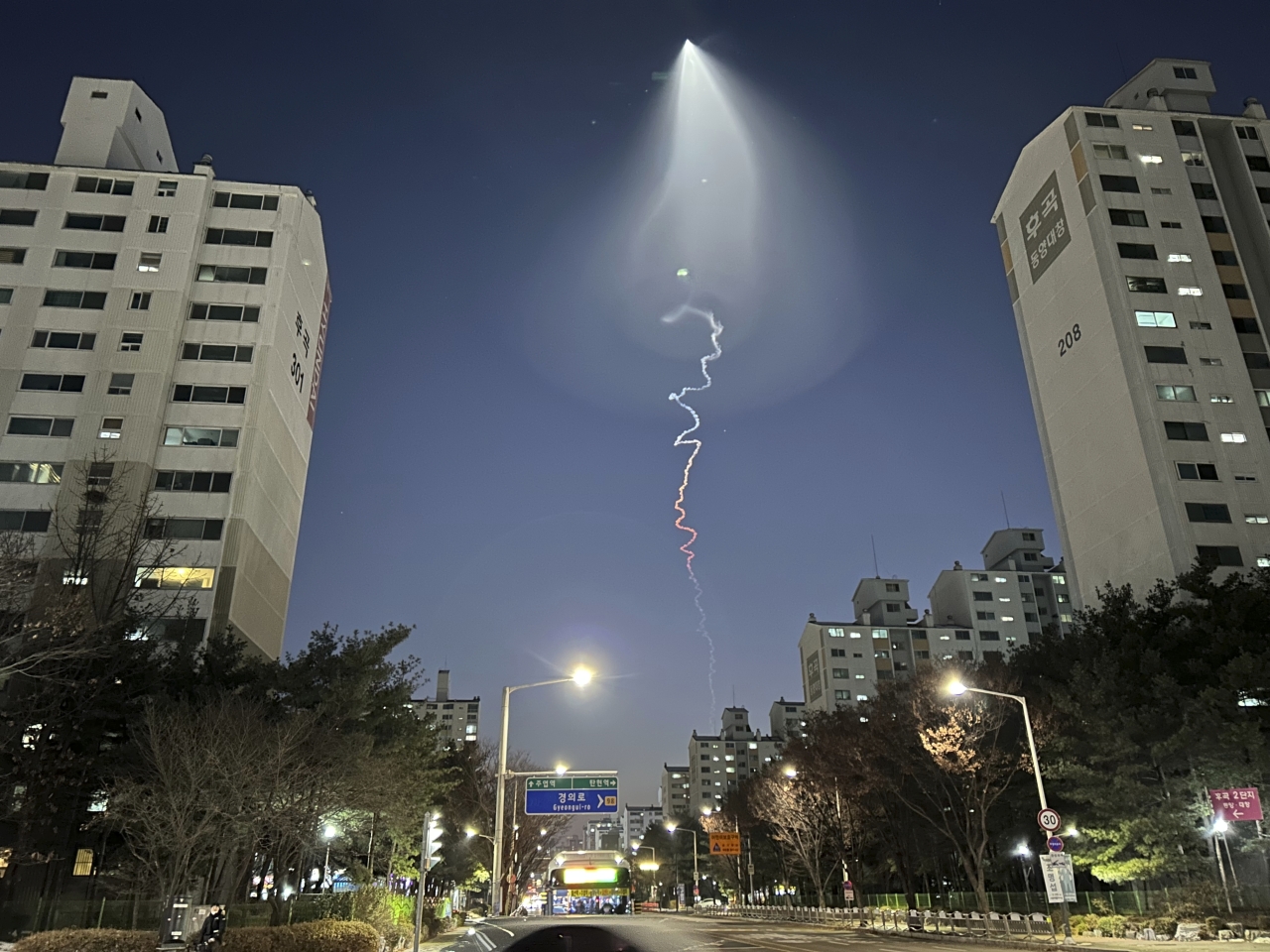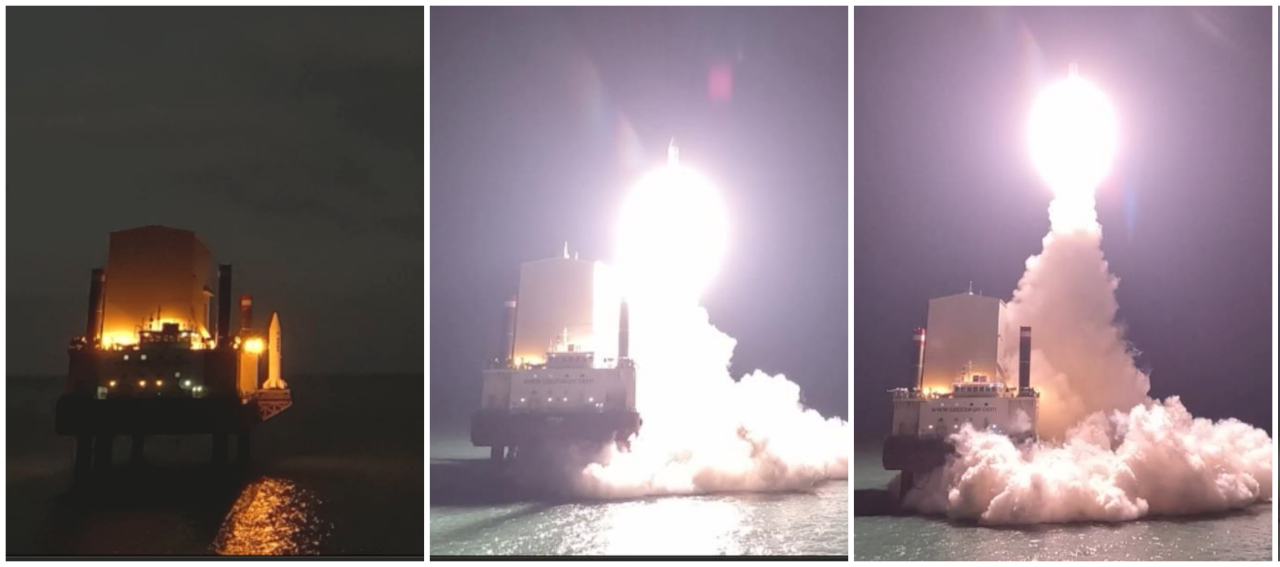Ministry sorry for poor communication after public alarmed by rocket test
By Ji Da-gyumPublished : Jan. 2, 2023 - 18:24

The Defense Ministry shared the details of the test flight that was conducted by the state-run Agency for Defense Development (ADD) on Friday after sunset in waters off the western coast to verify the performance of a homegrown solid-fuel space rocket.
The ministry underscored that the test was needed to prepare to independently launch microsatellites designed to monitor North Korean activities and strengthen military surveillance and reconnaissance capabilities.
Strange rainbow-colored lights were spotted in the sky in several parts of South Korea, causing some witnesses to initially speculate it was a UFO or North Korean missile. The tendrils of vapor prompted hundreds of calls to the police.
The ADD had to conduct the test flight in the evening in consideration of various factors, including weather conditions, and it sought to “minimize disruption to fishery operations in safety zones” set for the test launch, according to the ministry.
During a closed-door briefing, government officials said they were aware of the twilight phenomenon produced when a rocket launches after sunset causes a vapor trail. However, they were not aware that the twilight phenomenon would alarm the public.
The ministry would “come up with ways not to alarm the public, including setting up a system for immediate public notifications upon test launch vehicles,” a senior government official said.
But at the same time, it “sees difficulties in sending public notifications in advance” because this could affect the schedule of the test launch, the official said, without elaborating on the reasons why.
However, it was not the first time that the South Korean military failed to share key information about their operations in a timely way.
Friday’s test flight came days after uncrewed North Korean aerial vehicles intruded into South Korea and flew over Seoul and residential areas along the western inter-Korean border last week.
The military requested a press embargo on the cross-border infiltration for around 5 hours. The public were not informed of why flights departing from Incheon Airport and Gimpo International Airport were suspended.
The military also faced criticism in early October for its slow response to a failed missile launch that rattled residents in the coastal city of Gangneung. At that time, the fire and loud noise from the crash triggered panic among residents late in the evening, but it was not until next morning the military explained the cause.

“Our military will significantly develop our own space-based surveillance and reconnaissance capabilities by developing space launch vehicles which are capable of putting small or ultra-microsatellites into low-Earth orbit in a few years, based on our technology and know-how related to solid propulsion systems,” the Defense Ministry said in a press statement.
The South Korean military needs to “put a large number of microsatellites to develop surveillance and reconnaissance capabilities” and to monitor North Korea in real time with a shorter revisit time, one senior government official in charge of developing solid-fuel rockets said during a closed-door briefing on Monday morning. The revisit time is the time interval between observations of the same location on Earth via satellites.
Despite escalating North Korean missile and nuclear threats, the South Korean military has largely relied on the US’ intelligence, surveillance and reconnaissance assets as it has not yet independently launched a spy satellite capable of monitoring North Korean activities.
In addition, the two Koreas have been in competition. North Korea has also set a goal of launching the country’s first military reconnaissance satellite by this April. North Korean leader Kim Jong-un ordered the launch of the first spy satellite in the “shortest period of time possible” during the year-end party plenum, North Korean state media reported on Sunday.
The South Korean military currently plans to launch the first microsatellite mounted on a solid-fuel space rocket into a low-Earth orbit by 2025.
Meanwhile, the South Korean military launched a new division committed to countering escalating missile and nuclear threats from North Korea, the Joint Chiefs of Staff said Monday, adding that the division will be later expanded into the “strategic command.”
The establishment of the Directorate of Countering Nuclear and Weapons of Mass Destruction (WMD) aimed to “drastically strengthen the military’s deterrence and response capabilities and readiness posture against various evolving North Korean threats.”


![[AtoZ into Korean mind] Humor in Korea: Navigating the line between what's funny and not](http://res.heraldm.com/phpwas/restmb_idxmake.php?idx=644&simg=/content/image/2024/04/22/20240422050642_0.jpg&u=)


![[Herald Interview] Why Toss invited hackers to penetrate its system](http://res.heraldm.com/phpwas/restmb_idxmake.php?idx=644&simg=/content/image/2024/04/22/20240422050569_0.jpg&u=20240422150649)
![[Graphic News] 77% of young Koreans still financially dependent](http://res.heraldm.com/phpwas/restmb_idxmake.php?idx=644&simg=/content/image/2024/04/22/20240422050762_0.gif&u=)

![[Exclusive] Korean military set to ban iPhones over 'security' concerns](http://res.heraldm.com/phpwas/restmb_idxmake.php?idx=644&simg=/content/image/2024/04/23/20240423050599_0.jpg&u=20240423171347)






![[Exclusive] Korean military to ban iPhones over security issues](http://res.heraldm.com/phpwas/restmb_idxmake.php?idx=652&simg=/content/image/2024/04/23/20240423050599_0.jpg&u=20240423171347)



![[Today’s K-pop] Ateez confirms US tour details](http://res.heraldm.com/phpwas/restmb_idxmake.php?idx=642&simg=/content/image/2024/04/23/20240423050700_0.jpg&u=)